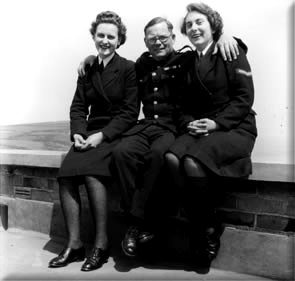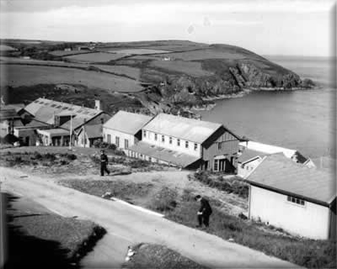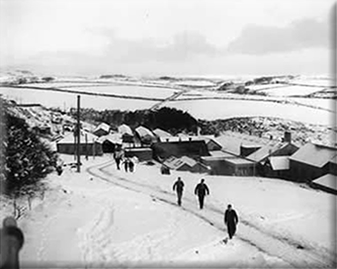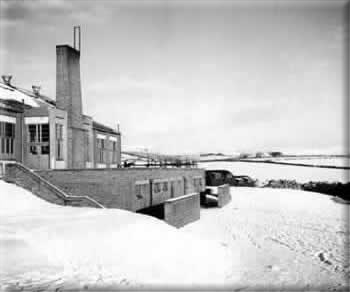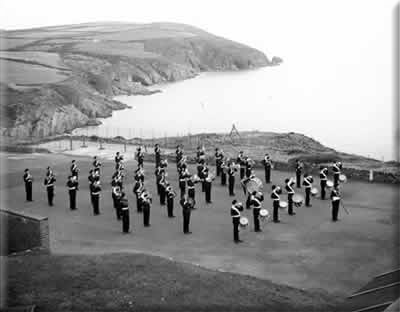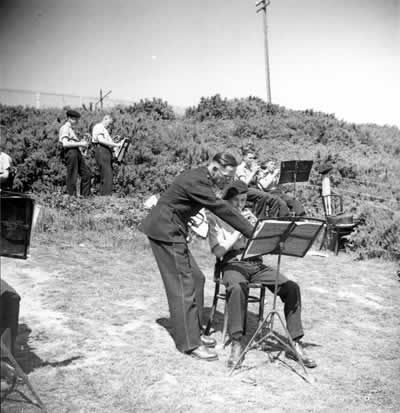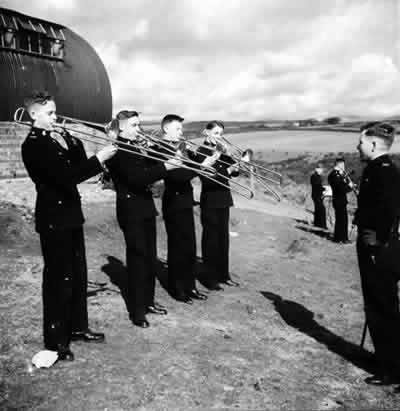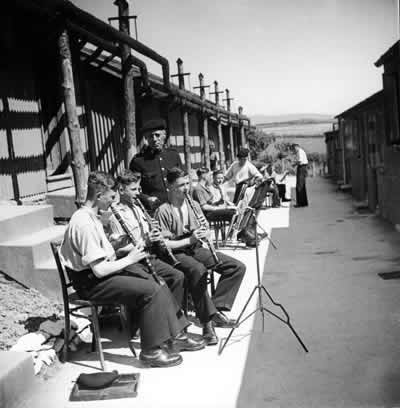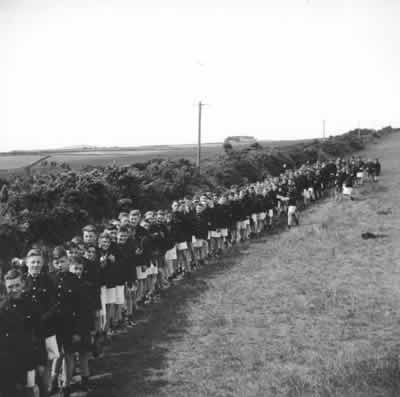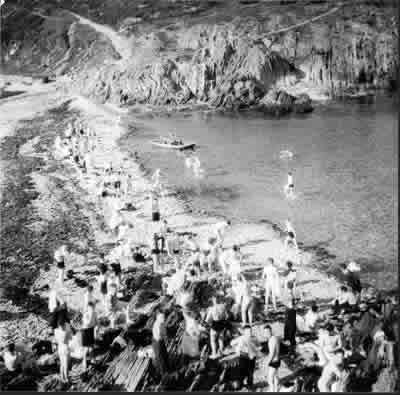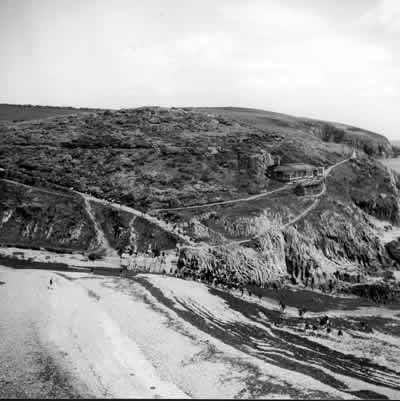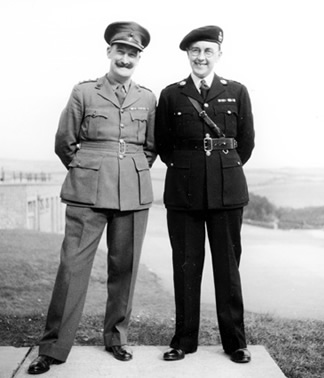
Memories
of Howstrake Camp Pt I by Tom Lambert |
First
published by the Blue Band magazine |
|
As far as is known, apart from John Trendell's clinically factual chapter in his 'Operation Music Maker' and ex BdCpl Don Flounders' splendid memoir, no authorised history exists of the period that the Junior wing of the RNS of M spent at Howstrake Camp in the Isle of Man between 1941 and 1945. In this our Centenary year I offer the following article, which does not attempt to redress that situation, but shows, by photograph and description, what life was like for the boys during that time. I was one of those boys and remember the period with great fondness for it was one of the happiest and most formative periods of my life. I was the junior member of 78 Squad which joined in 1941, the year in which the School was billeted there. Howstrake Camp was what was laughably called a Holiday Camp. That is, it was originally a place where families went for their summer break to get away from it all. Nobody seems to know when it was built but it was along the lines of those early camps built by Billy Butlin, famous progenitor of the cheap holiday encampment. Perhaps a local entrepreneur built it for unsuspecting Manxmen? It was a brilliant idea to commandeer it for use as a School of Music, on the outskirts of civilisation as it was, where few people might be expected to complain of noise levels. During our time there it provided low cost, low maintenance accommodation of the sort that one might expect to find at Dartmoor or other similar houses of corrections. Several hundred boys lived there over the period and despite the Spartan conditions seemed to relish it as some sort of adventure. I know I did. The splendid photographs that follow will go some way to show their daily lives. For this we are indebted to Peter Brain who retrieved them from his father's belongings and gave me permission to use them for this article. It would therefore be less than just not to include a few words about the photographer. At the time he took these pictures he was a First Class Bandmaster serving as the French Horn Instructor at Howstrake. He served there between 1943 and 1945. He had joined the Royal Naval School of Music on his 14th birthday in 1923. Born in Gosport he was the eldest of five children, one of whom also became a musician in the RNS of M and who was killed in HMS Bonadventure when it was torpedoed in the Mediterranean in 1942. As was common in those days, between the two Great Wars of 1914-18 and 1939-45, Bandmaster Brain served in many ships and was more often than not at sea during most of the period from completion of his training until his appointment to the Junior Wing in 1943. We are fortunate that his interest in photography left us the following record of that period.
Pictures
2 and 3 (above) show the upper part of the camp and the nearby
countryside in both summer and winter; very often it was hard to tell
the difference! The Irish Sea is in the background and had to be negotiated
by ferry to get to the mainland, making escape from the island all
but impossible. Almost inevitably, when seasonal leave came around
and the boys were taken down to the ferries the seas would be a heaving
maelstrom of white horses and the six or eight hour journey to Fleetwood
would be a nightmare of moaning bodies, the stench of oily engines
mixed with the all pervading and ever present aroma of Manx Kipper.
"Oh they can't take that away from me". The main gate was
at the top of the roadway in the foreground through which all boys
passed on their way in and out of camp. The eagle eye of the duty
NCO would always detect the wrong angle of a cap, any other uniform
discrepancies too numerous to mention and, horror of horrors, if a
boy had been foolish enough to imbibe a half pint of very watery beer
down in the capital of Douglas. The pathway down the hill was often
negotiated by PTI Cpl Spike Sullivan, at high speed, on his bicycle,
usually terminating at the tennis courts at the bottom, where he would
athletically leap into the air, legs astride, and the bike would crash
into the wire netting surrounding the courts. Sullivan, a very popular
NCO, would look about as if nothing untoward had happened, adjust
his dress as they say, and head for the gym and the day's work. His
Boss, Colour Sgt Micky Hunt was another character, whose favourite
saying was, "Go on Boy, 'it me, 'it me". He had been the
Corps Heavyweight boxing champion for many years and used to take
us all for lessons in the gentle art of self defence. If he thought
you weren't putting all you had into it he would exhort, Go on Boy,
'it me. If you did manage it he would have a laugh and if you didn't,
you got a fairly stiff jolt from a left jab.
Picture 5 speaks for itself, Band Drill training, most of which was done at the halt it being somewhat easier that way. The interesting tripod, or sheer-legs in Naval parlance which can be seen in the background, was the means by which the instructors won every tug of war competition throughout the Island and which they took very seriously indeed, training every forenoon before breakfast and hauling on the rope against literally tons of dead-weight. How they ever gave any instruction thereafter remains a mystery, most of them, bless their cotton socks, were heavy drinkers and even heavier smokers.
Talking of instruction brings into the frame picture No 6. This picture is very interesting indeed as it shows the very enlightened approach by the authorities to the need for sound proofed private practice spaces. This notion was taken up by the Royal Academy of Music some years later. Notice the amount of space around each player and the very pleasant greenery and gorse all around. The only slightly disturbing part of the picture is the evidence of the electrified fence at the top. This provided a necessary deterrent and prevented mass break-outs which occasionally threatened. Can anyone of the era name anyone in the picture? The instructor is Bdmr Beecham (no relation) who used to coach the Dance Band.
Very similar is picture No 7. In this picture Band Boy Chris Taylor is second from the left. He subsequently became a Captain, Director of Music, and was a very fine trombonist. On his left is Band Boy M A G Hadley (I think) and again I think Band Boy John Borrington. The other chap I cannot place but no doubt I shall hear all about it soon.The instructor appears to be Bandmaster Nutty Duncan, an exceptional player, a particularly fine pianist who, in later life was Director of Music of the Fiji Police Band. Oh what fun it was to have trombones roaring in your ears as you practised the clarinet a few metres away!
Picture No 8 is a quite illuminating one. It shows a number of features which are of great interest the first of which has to be the three clarinet students in the foreground. The one closest to the camera, unless I am very much mistaken is Band Boy Paul Neville, who, nobody will need reminding, went on to become the Principal Director of Music after Sir Vivian Dunn retired. He and I went to the Royal Academy of Music together and I have considered him a friend for sixty years. Next to him is, I think Titch Comber, and whilst I know the other one, age prevents me from naming him. The other feature which will interest first time viewers is the avenue between accommodation blocks. These were the rooms that Band Boys lived in, possibly sixteen to a room, just about the size of your average sardine tin. The pipe organ arrangement is not, in fact, a pipe organ at all but rather the means of heating the rooms in the winter. Super (ha ha) heated steam was carried from the boiler room by means of these pipes, consider the distance alone from source, and you will get some notion of how ineffective they were. They were, on the other hand a very good means of heralding the arrival of an NCO, so that if you banged on the pipe in the end rooms the reverberation continued all the way to the far end thus warning you to beware.
Picture
No 9 is one that I expect will cause a good deal of speculation.
With a magnifying glass and a powerful torch I have been able to name
8 or 9 Boys including DEW Smith, Eddy Stigwood, Johnny Quaye, Ginger
Yates, Johnny Browning and a few others whose names slip in and out
of memory. The Section Leader with the clip board towards the tail
end of the queue could be, repeat, could be, my old friend Bill Hamley
but maybe not. This shot seems to have been taken at the RT or Sports
field, but if so, we are standing on the wrong side of the field for
the run back to the camp. It was customary to check that everyone
was present and hadn't magicked themselves away during the games period,
hence the Section Leaders with the clipboards. Despite the relatively
happy mood of the picture there seem to be a good many Churchillian
Victory signs being accorded the photographer, perhaps he was asking
for too much forced cheerfulness. The RT Field was about a mile and
three quarters from the camp so that even when you had finished soccer,
rugby or whatever there was still the run back to the camp, with Kippers
for tea at the end of it, having had them for breakfast and lunch,
with the prospect of having them for dinner, or supper also. Very
health giving, if somewhat boring, especially after four weeks of
the same diet in the season. How many Boys can you remember and name?
Picture No 11 shows the afternoon run down the steps, across the beach and up the other side to the RT Field. You will see all those snivelling wretches that wanted to get there first, perhaps half a mile in front of their colleagues, mostly older boys who had the 'bin there, done that' attitude and didn't intend to run unless the PTI got serious about it… It can easily be seen how rugged the terrain is and how unforgiving to young legs, no matter how fit. I can't honestly say who owned, or lived in the house which is featured on the side of the hill, it certainly didn't belong to the camp. Now I expect someone will say 'Oh Yes it did'. The little stream that flowed out of Groudle Glen can be seen in the lower centre of the picture, and over which we had to pass to get to the path up to the field. It too, was icy at all times of the year and the source of much discomfort both going and coming.
Picture 12 shows two of the officers responsible for discipline and training at that time. The very jaunty looking fellow in Khaki with the Flying Officer Kite type moustache, was Captain George Keen, the Director of Music, a man of great patience and forbearing. He could look very fierce under that moustache but I rarely ever heard a cross word from him. His Deputy (not the man in the picture) was Lt A C Green the famous arranger of Sunset, a splendid minor composer who retired into a job as the BBC Music Librarian. He conducted the Boys' Orchestra, in which I well remember playing a delicious little piece of his called Moon Maiden. I wonder if it is still extant? The other officer, is a Commissioned Bandmaster (a rank which no longer exists) one Dougie Jarman, a very pleasant, somewhat scholastic man which is evident from this picture. Click [Here] for memories part II
|
